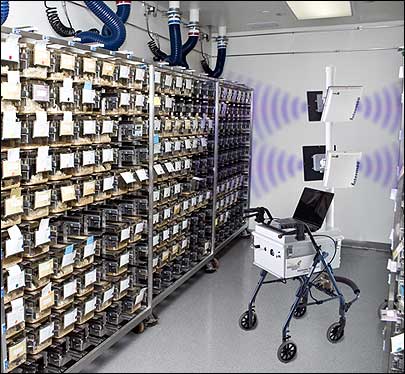The University of Florida (UF) is employing an RFID system to track thousands of rodents housed for research and experimentation. The college had been testing and expanding the system for the past year, and currently tracks about 6,000 cages of laboratory rats and mice, with plans to track all 11,000 cages in its custody by March 1, 2008. That amounts to about 35,000 rodents.
The system, provided by data-collection solutions firm Dynasys, enables the school’s department of animal-care services to better track the movement of the animal cages for billing accuracy, and spares the university staff hours of labor spent conducting regular inventories of the cages and animals.

UF’s department of animal-care services houses and provides care for research animals at a fee, charged to the researcher or directly to the grant funding the research. For about 84 cents a day per animal, the department feeds and cares for the research animals, which are caged alone or in groups of up to five. Researchers generally pay for the animal care through the grants received from government agencies or other sponsors. However, tracking thousands—or even hundreds of thousands—of cages at a facility on a regular basis can be extremely time-consuming and fraught with errors. Employees either check the ID on the handwritten cards (known as protocol cards) attached to each cage, or use a bar-code scanner to read each cage’s bar-coded label.
UF employees previously used mobile bar-code readers to scan the cage numbers, according to UF’s attending veterinarian and director of animal-care services, August Battles. Inaccuracies occurred when an employee failed to scan all the cages, and if a cage was misplaced—put in the wrong room, for instance—finding it and moving it to the correct location could be a time-consuming endeavor. Researchers often questioned the university’s billing statements, and there were times when a cage remained in UF custody and the animals were cared for, but the researchers were not billed because the cage was not scanned and inventoried.
Battles turned to Texas Instruments (TI) in early 2006, looking for an automated, RFID-based system. TI recommended the university work with Dynasys, based in Clearwater, Fla., to develop a tracking system. Battles, together with UF engineering professors and Dynasys representatives, discussed and planned the solution for about six months before installing it last winter.
With the new system, the department of animal-care services staff fit each cage with an EPC Gen 2 passive UHF tag, provided by Dynasys (and made with TI’s EPC Gen 2 chip). Each cage tag number is associated with details about the specific research project in which the animals housed in the cage are involved, and with the researcher leading the project, in a Web-based back-end system hosted by the University of Florida. Also attached to each cage is a protocol card printed with information about the research, as well as the housing agreement and cage ID number.
To conduct inventory, a staff member pushes a cart, carrying a mobile Intermec EPC Gen 2 RFID interrogator and a laptop running Dynasys software, past the cages, capturing the tags’ unique ID numbers. The employee performing the inventory can view a real-time count of how many and which cages should be located in the room, and whether the RFID tags read match what is expected. If a cage is identified that should not be in the room, or if cages come up missing, the software generates an alert.
At the end of each inventory process, Dynasys’ software puts the complete inventory data in a format for use by the accounting department, then transmits it to the school’s Web-based back-end system via a Wi-Fi connection. From there, animal-care services administrators can access the report to appropriately bill the housing costs of animals based on tag reads, or begin investigating a missing cage. Researchers can also access data by logging onto the Web site and inputting a password and research ID number.
The return on UF’s investment in the system occurred almost immediately, simply from labor savings, says Bob Scher, Dynasys’ CEO. The cost of outfitting a research lab the size of UF’s with the system, including hardware, software and installation is typically about $100,000, Scher says, but can be more, depending on the size of the facility.
Since the UF system was installed, says Evan Hochman, UF’s IT director for animal-care services, the accuracy rate—that is, the specific cages reported to be in UF custody that actually are in the college’s possession —has gone from 60 percent to 99 percent.
For labs without Wi-Fi network coverage throughout their research facilities, the mobile interrogator can store the data until it receives a Wi-Fi signal, or until it is plugged into a PC and can download the information through an Ethernet link.
Suppliers or distributors of genetically engineered mice could also employ the Dynasys system to better track the animals and their movement by monitoring where cages are located in the laboratory, Scher says, and when they are shipped out. In addition, the system could be expanded to retain additional data about the progress of the research itself, including storing data about each mouse’s health condition and the type of research being done.
Over the past year, Battles says, “we’ve seen an increase in revenue” with the RFID system, by reducing such errors as housing a cage of mice without billing for them. He adds that “the researchers are confident in what we’re doing. There is no longer a question of accuracy in billing.” Eliminating billing errors, Battles estimates, has increased revenue by about 20 percent. The system will also make it easier for the university to expand its animal-care facilities, he adds, with the capability of housing up to 30,000 cages over the next two years.
Since the system was launched, other universities and private scientific research laboratories have visited the campus to view the cage tracking in action,Battles says.
According to Scher, the Dynasys solution uses a customized version of Dynasys’ warehouse-management software, tracking rodent cages in a manner similar to how distribution centers track crates and pallets in warehouses. This application, he claims, “is very unique and very cost-effective.”



